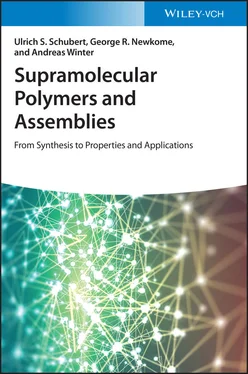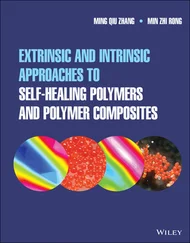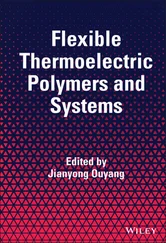Andreas Winter - Supramolecular Polymers and Assemblies
Здесь есть возможность читать онлайн «Andreas Winter - Supramolecular Polymers and Assemblies» — ознакомительный отрывок электронной книги совершенно бесплатно, а после прочтения отрывка купить полную версию. В некоторых случаях можно слушать аудио, скачать через торрент в формате fb2 и присутствует краткое содержание. Жанр: unrecognised, на английском языке. Описание произведения, (предисловие) а так же отзывы посетителей доступны на портале библиотеки ЛибКат.
- Название:Supramolecular Polymers and Assemblies
- Автор:
- Жанр:
- Год:неизвестен
- ISBN:нет данных
- Рейтинг книги:3 / 5. Голосов: 1
-
Избранное:Добавить в избранное
- Отзывы:
-
Ваша оценка:
- 60
- 1
- 2
- 3
- 4
- 5
Supramolecular Polymers and Assemblies: краткое содержание, описание и аннотация
Предлагаем к чтению аннотацию, описание, краткое содержание или предисловие (зависит от того, что написал сам автор книги «Supramolecular Polymers and Assemblies»). Если вы не нашли необходимую информацию о книге — напишите в комментариях, мы постараемся отыскать её.
The book details many of the exciting developments in the field of supramolecular chemistry that have occurred since the 1987 Nobel Prize was awarded to pioneers in this rapidly developing field. Readers will also benefit from the inclusion of:
A thorough introduction to supramolecular assemblies based on ionic interactions Explorations of supramolecular polymers based on hydrogen-bonding interactions, metal-to-ligand interactions, p-Electronic interactions, crown-ether recognition, cucurbiturils, and host-guest chemistry of calixarenes A discussion of cyclodextrins in the field of supramolecular polymers Examinations of supramolecular polymers based on the host-guest chemistry of pillarenes, and those formed by orthogonal non-covalent interactions A treatment of the characterization of supramolecular polymers
will earn a place in the libraries of researchers and practitioners of the material science, as well as polymer chemists seeding a one-stop reference for supramolecular polymers.
Supramolecular Polymers and Assemblies — читать онлайн ознакомительный отрывок
Ниже представлен текст книги, разбитый по страницам. Система сохранения места последней прочитанной страницы, позволяет с удобством читать онлайн бесплатно книгу «Supramolecular Polymers and Assemblies», без необходимости каждый раз заново искать на чём Вы остановились. Поставьте закладку, и сможете в любой момент перейти на страницу, на которой закончили чтение.
Интервал:
Закладка:
7 Chapter 7Figure 7.1 Schematic representation of the generalized CB[ n ] synthesis via co‐condensation of 1with formaldehyde under acidic conditions. The dimensions of different CB[ n ] representatives are listed [5]. The ball‐stick representation of the solid‐state structure of CB[8] is also shown. Source: Kim et al. [4], © 2000 American Chemical Society.Figure 7.2 Schematic representation of the various exclusion and inclusion complexes of CB[ n ]s. Source: Barrow et al. [16].Figure 7.3 Schematic representation of the formation of supramolecular polymers via complexation of BB‐ or ABBA‐type monomers by a CB[ n ] host. Source: Redrawn from Yang et al. [33], © 2015 American Chemical Society.Figure 7.4 Schematic representation of the formation of a surface‐anchored supramolecular polymer (counterions omitted for clarity). Source: Kim et al. [53], © 2004 American Chemical Society.Figure 7.5 Schematic representation of the formation of the supramolecular polymer { 4@CB[8]} n; the assembly into 1 : 1 or 2 : 2 species is prevented due to steric and electronic constraints, respectively. Source: Liu et al. [55], © 2010 John Wiley and Sons.Figure 7.6 Schematic representation of a supramolecular polymer based on metal‐to‐ligand coordination and host–guest complexation. Source: Liu et al. [56], © 2013 The Royal Chemical Society.Figure 7.7 (a) Schematic representation of the bifunctional monomer 6(counterions were omitted for clarity). (b) Side view of the X‐ray single crystal structure of { 6@CB[8]} n. Source: del Barrio et al. [57], © 2013 American Chemical Society.Figure 7.8 (a) Schematic representation of the ditopic monomers 7to 9. (b) Schematic representation of the linear supramolecular polymer { 9@CB[8]} n. Source: Liu et al. [59], © 2013 John Wiley and Sons.Figure 7.9 Schematic representation of the imidazolium‐containing guests 10and 11. (a) Schematic representation of the step‐wise self‐assembly of 11and CB[8] into linear polymer chains and, subsequently, fibrous aggregates. (b) Representative AFM images of the crystalline nanostructures obtained from 10/CB[8] (left) and 11/CB[8] (right). Source: Barrio et al. [62]. Figure reproduced with kind permission; © 2019 American Chemical Society. Licensed under CC BY 4.0.Figure 7.10 (a) Schematic representation of the self‐assembly of 12and CB[8] into 2 : 2 dimers and linear polymers due to the formation of H‐ or J‐type aggregates within the hosts' cavities. (b) Representation of the structure of oligomeric { 12@CB[8]} naccording to molecular modeling. Source: Xu et al. [63], © 2011 The Royal Chemical Society.Figure 7.11 (a) Schematic representation of the homoditopic monomer 13. (b) Schematic representation of the proposed 2 : 1 binding mode. (c) AFM–SMFS curves of the supramolecular polymer { 10@CB[8]} nand the Gaussian fitting thereof. Source: Tan et al. [60], © 2013 Royal Society of Chemistry.Figure 7.12 (a) Schematic representation of the formation of a cyclic 1 : 1 complex via a ring‐chain equilibrium pathway. (b) Schematic representation for the inhabitation of protein complexation due to the formation of the highly stable cyclic complex. Source: Ramaekers et al. [67], © 2013 Royal Society of Chemistry.Figure 7.13 (a) Schematic representation of the formation of a discrete 2 : 3 complex and (b) a 2D supramolecular organic framework due to radical dimerization stabilized by CB[8]. Source: Zhang et al. [72], © 2014 Royal Society of Chemistry.Figure 7.14 (a) Schematic representation of the self‐assembly of the MV˙ +radical cation and CB[8] into a 2 : 1 complex. (b) Schematic representation of the hexacationic ditopic guest 14. Source: Redrawn from ref. Yin et al. [76], © 2013 Chinese Chemical Society.Figure 7.15 Schematic representation of the proposed equilibrium for the self‐assembly of a bis‐CB[10] derivative with a bis‐adamantyl guest into discrete complexes and linear supramolecular polymers. Source: Nally and Isaacs [85], © 2009 Elsevier.Figure 7.16 Schematic representation of the synthesis of CyP nTD[ n ] macrocycles. The solid‐state structure of CyP 4TD[4], as determined by single crystal X‐ray analysis, as well as the cavity dimensions of the CyP nTD[ n ] derivatives are also shown. Source: Wu et al. [86], © 2017 Royal Society of Chemistry.Figure 7.17 Schematic representation of the formation of a supramolecular polymer network with AIE behavior. A representative TEM image of the polymer particles is also depicted. Source: Wu et al. [88], © 2018 Royal Society of Chemistry. Figure reproduced with kind permission; © 2018 The Royal Chemical Society.Figure 7.18 Schematic representatio of the two‐step self‐assembly of the TPE dyes 15and 16into cubic or spherical nanostructures, respectively. Representative TEM images visualizing these nanostructures are also depicted. Source: Li et al. [90]. Figure reproduced with kind permission; © 2018 Wuiley‐VCH.Figure 7.19 Schematic representation of the self‐assembly of 2 : 1 heterotrimers due the formation of a CT complex within the CB[8] cavity; (a–c) three applications of this particular interaction using polymeric building blocks are also shown. Source: Rauwald and Scherman [96], © 2008 John Wiley and Sons.Figure 7.20 Schematic representation for the formation of a supramolecular ABA‐type triblock copolymer. Source: Zayed et al. [98], © 2014 Royal Society of Chemistry.Figure 7.21 Schematic representation of the step‐wise, self‐assembly of supramolecular micelles that could be used for the controlled release of doxorubicin, as a model drug. The release, as a function of the added reducing agent, is also shown. Source: Zhao et al. [99], © 2014 Royal Society of Chemistry.Figure 7.22 Schematic representation of the temperature‐triggered formation of double‐layered vesicles from supramolecular lipid–peptide conjugates. Source: Loh et al. [102], © 2014 Royal Society of Chemistry.Figure 7.23 Schematic representation of the stepwise formation of vesicles from an initial mixed micellar system by CB[8]‐triggered self‐sorting. Source: Mondal et al. [104], © 2014 American Chemical Society.
8 Chapter 8Figure 8.1 Schematic representation of the macrocyclic hosts calix[ n ]arene and resorcin[ n ]arene (R denotes any substituent; whereas, n and m = n − 3 refer to the number of phenyl moieties within the macrocycle).Figure 8.2 Schematic representation of the tetraurea‐functionalized calix[4]arene (a) and of its dimer with an encapsulated small guest molecule (b) [21]. Source: Redrawn from Dalcanale and Pinalli [19], © 2015 Springer Nature.Figure 8.3 Schematic representation of the self‐assembly of calix[4]arene dimers 2into polycaps [21]. Source: Redrawn from Dalcanale and Pinalli [19], © 2015 Springer Nature.Figure 8.4 Schematic representation of the depolymerization of a polycap in the presence of a dimeric capsule into a dumbbell‐shaped 2 : 1 complex [21]. Source: Redrawn from Dalcanale and Pinalli [19]. © 2015 Springer Nature.Figure 8.5 Schematic representation of different polycaps derived from homo‐ or heteroditopic bis‐calixarenes (black calixarenes are equipped with aryl ureas, gray calixarenes carry sulfonyl ureas). Source: Castellano et al. [24], © 1998 American Chemical Society.Figure 8.6 (A) Photomicrographs of a typical Schlieren texture observed from a LC polycap in CHCl 3(a) and p ‐difluorobenzene (b) as viewed between crossed polarizers. (B) Laser confocal microscopy images of fibers assembled from the LC phases of the polycap in CHCl 3either by sample shearing (a) or fiber pulling from the sample (b). Source: Castellano et al. [25]. Figure reproduced with kind permission; © 1999 Wiley‐VCH.Figure 8.7 Schematic representation of the bis‐calixarene 3comprising a pH‐sensitive dipeptide linker that could be used to switch between a soluble and insoluble form of the resulting polycap. Source: Redrawn from Xu et al. [27], © 2003 American Chemical Society.Figure 8.8 Schematic representation of the two‐step assembly of a supercap by (a) calixarene dimerization in an apolar solvent and (b) binding of CO 2. Source: Redrawn from Xu et al. [29].Figure 8.9 Schematic representation of the bis‐calixarene 5, as a building block for the two‐step assembly of a stimuli‐responsive organogel [30]. Source: Redrawn from Guo et al. [18], © 2012 Royal Society of Chemistry.Figure 8.10 Schematic representation of the bis‐calixarene 6equipped with a pending pyrene moiety. Source: Modified from Xu and Rudkevich [32].Figure 8.11 Schematic representation of bis‐calixarenes, connected via their upper rims. Depending on the structure of linker inter‐ and/or intramolecular association is enabled. Source: Guo and Liu [18], © 2012 Royal Society of Chemistry.Figure 8.12 Schematic representation of the formation of a supramolecular polymer with vacant calixarene moieties. Source: Liu et al. [37], © 2002 Taylor & Francis.Figure 8.13 Schematic representation of the calix[4]arenes 8and 9equipped with H‐bonding moieties. These were used for the self‐assembly of supramolecular polymeric nanostructures. Source: Klok et al. [42], © 1999 American Chemical Society.Figure 8.14 Schematic representation of resorcin[4]arene 10and calix[4]arene 11. Source: Baldini et al. [45], © 2011 American Chemical Society.Figure 8.15 Schematic representation of cavitands 12and 13. The latter one was used as AB‐type monomer in a supramolecular polymerization. Source: Dalcanale and Pinalli [19], © 2015 Springer Nature.Figure 8.16 (a) Representation of the solid‐state structure of poly‐ 13(perpendicular view to the polymer chains) [52]. (b) Schematic representation of the star‐shaped supramolecular polymer, derived from a template‐driven self‐assembly using a planar tetratopic guest, as core. Source: Yebeutchou et al. [52], © 2008 John Wiley and Sons.Figure 8.17 Schematic representation of the p ‐ tert ‐butylcalix[5]arenes 14–16. Source: Pappalardo et al. [56].Figure 8.18 Schematic representation of the bis‐calix[5]arenes 17and the alkyl‐diammonium salts 18used for the self‐assembly into the supramolecular architectures A‐D. Source: Gattuso et al. [60], © 2008 American Chemical Society.Figure 8.19 Schematic representation of the homoditopic “bis‐container” 19for the complexation of fullerene derivatives, such as the dumbbell‐shaped bis‐fullerene 20and the polyacetylene 21with fullerene side chains.Figure 8.20 Schematic representation of the formation of a supramolecular coil–rod–coil triblock copolymer. Source: Hirao et al. [67], © 2020 American Chemical Society.Figure 8.21 Schematic representation of the homoditopic AA‐type bis‐cavitand hosts ( 22) and BB‐type guests ( 23) used for supramolecular polymerization. Source: Tancini et al. [69], © 2010 John Wiley and Sons.Figure 8.22 Representation of the crystal structure of the linear supramolecular polymer obtained from the self‐assembly of 22c and MV 2+(the counterions are omitted for clarity). Source: Tancini et al. [69], © 2010 John Wiley and Sons.Figure 8.23 (a) Schematic representation of the p ‐sulfonatocalix[ n ]arene 24and the corresponding homoditopic hosts 25and 26. (b) Schematic representation of the self‐assembly of 25into a linear or net‐like polymer upon complexation of a dicationic or tetracationic guest. Source: Guo et al. [71], © 2009 John Wiley and Sons.Figure 8.24 Schematic representation of the tetracationic bis‐viologen guests 27and their use in the self‐assembly with bis‐calixarene 26to afford linear polymer or cyclic oligomers. Source:(a) Redrawn from Guo et al. [73,74] © 2010 Royal Society of Chemistry; (b) Redrawn from Qian et al. © 2012 John Wiley and Sons.Figure 8.25 Schematic representation of the synthesis of a ternary supramolecular polymer via a two‐step self‐assembly approach. Source: Redrawn from Qian et al. [74], © 2012 John Wiley and Sons.Figure 8.26 Schematic representation of the pH‐ and redox‐sensitive supramolecular polymer assembled from bis‐calixarene 26and the heteroditopic guest 28. Source: Redrawn from Ma et al. [77], © 2011 Royal Society of Chemistry.Figure 8.27 Schematic representation of the multifunctional guest 29and the chiral supramolecular polymer derived by binding of α‐CD and 26. The polymer showed a light‐driven isomerization that could be monitored by SEM imaging of the dried cast films on glass slides. Source: Sun et al. [78]. Figure reproduced with kind permission; © 2013 American Chemical Society.Figure 8.28 Schematic representation of calix[4]pyrrole ( 30). The four most relevant conformations (a) as well as the anion‐induced transformation from the 1,3‐alterante to the cone‐shaped conformation (b) are also shown. Source: Wu et al. [80], © 2001 The Royal Chemical Society.Figure 8.29 Schematic representation of the TTF‐functionalized calix[4]pyrroles 31, which, in their 1,3‐alternate conformation, accommodated two electron‐poor guests. The conformation of 33could be switched reversibly by adding chloride anions. Source: Nielsen et al. [88], © 2004 American Chemical Society.Figure 8.30 Schematic representation of the dicationic calix[4]pyrrole‐based guests 32. (a) Schematic representation of the structure of the supramolecular polymer assembled from 31cand 32a; a representative SEM image visualizing the solid‐state morphology of the material is also shown. (b) Schematic representation of the supramolecular assemblies formed by the depolymerization of ( 31c⋅⋅⋅32a) nin the presence of TBAI (left) and TEAI (right). Source: Kim et al. [91], © 2013 American Chemical Society. Figure reproduced with kind permission; © 2013 American Chemical Society.Figure 8.31 (a) Schematic representation of the flexible, ditopic guests 33. (b) Evolution of the DP as a function of the monomer concentration in different solvents (MCH: methylcyclohexane; DCE: 1,2‐dichloroethane). Source: Bähring et al. [92], © 2014 The Royal Chemical Society.Figure 8.32 (a) Schematic representation of the complementary ditopic monomers 34and 35, which gave a linear supramolecular polymer due to calix[4]pyrrole–carboxylate anion recognition. Source: Yuvayapan et al. [93], © 2019 The Royal Chemical SocietyFigure 8.33 Schematic representation of the PBI dye 30that was assembled into fibers upon addition of a p ‐sulfonatocalix[ n ]arene ( 24). The TEM, SEM, and AFM images (from the left to the right) of the nanostructures are also depicted. Source: Guo et al. [96]. Figure reproduced with kind permission; © 2012 The Royal Chemical Society.Figure 8.34 Schematic representation of the reversible self‐assembly of an amphiphilic molecule in the presence of a macrocyclic host. Source: García‐Rio and Basílio [101], © 2019 Elsevier.Figure 8.35 Schematic representation of the formation of a supramolecular amphiphile, as a thermoresponsive carrier for doxorubicin hydrochloride. A representative TEM image of the vesicles is also depicted. Source: Wang et al. [104]. Figure reproduced with kind permission; © 2010 Wiley‐VCH.Figure 8.36 Schematic representation of the multiple stimuli–responsive vesicles obtained from the self‐assembly of 24( n = 4) and 39. Source: Wang et al. [105], © 2011 American Chemical Society.Figure 8.37 Schematic representation of the multistep assembly of a linear supramolecular polymer from the heterodifunctional guest 40and two different types of hosts. The TEM images of the three types of assemblies observed in the study are also depicted. Source: Zhang et al. [106]. Figure reproduced with kind permission; © 2014 The Royal Chemical Society.Figure 8.38 Schematic representation of the self‐assembly of 41into vesicles and, in the presence of Ag(I) ions, spherical micelles. Source: Redrawn from ref. Houmadi et al. [122], © 2007 American Chemical Society.Figure 8.39 Schematic representation of the homoditopic guest 42that was assembled into spherical nanostructures in the presence of the sulfonated calix[4]arene 24(a) or bis‐calix[4]arene 26(b). Both types of nanostructures exhibited aggregation‐induced emission. Source: Redrawn from ref. Jiang et al. [107], © 2014 American Chemical Society.Figure 8.40 Schematic representation of calix[4]arene 43as a host for the self‐assembly into supramolecular micelles with chlorin‐e6 (Ce6). The size distribution as determined by DLS measurements (a) and a TEM image of the micelles (b) are also depicted. Source: Tu et al. [111]. Figure reproduced with kind permission; © 2011 The Royal Chemical Society.Figure 8.41 Schematic representation of an enzyme‐responsive supramolecular amphiphile for drug‐delivery applications. Source: Guo et al. [113], © 2012 American Chemical Society.Figure 8.42 Schematic representation of the self‐assembly of 44and 45into supramolecular amphiphiles. Source: Redrawn from Kharlamov et al. [115], © 2013 American Chemical Society.Figure 8.43 Schematic representation of the self‐assembly of 46and 47into supramolecular nanosheets. The TEM (a) and AFM (b) images of these nanosheets are also depicted. Well‐defined nanosheets, which are 1–2 mm long and 300–500 nm wide, are observed. Source: Yi et al. [116]. Figure reproduced with kind permission; © 2012 The Royal Chemical SocietyFigure 8.44 Schematic representation of a calix[8]arene‐based polypseudorotaxane. Source: Yamagishi et al. [119], © 2001 American Chemical Society.
Читать дальшеИнтервал:
Закладка:
Похожие книги на «Supramolecular Polymers and Assemblies»
Представляем Вашему вниманию похожие книги на «Supramolecular Polymers and Assemblies» списком для выбора. Мы отобрали схожую по названию и смыслу литературу в надежде предоставить читателям больше вариантов отыскать новые, интересные, ещё непрочитанные произведения.
Обсуждение, отзывы о книге «Supramolecular Polymers and Assemblies» и просто собственные мнения читателей. Оставьте ваши комментарии, напишите, что Вы думаете о произведении, его смысле или главных героях. Укажите что конкретно понравилось, а что нет, и почему Вы так считаете.












